Keyloggers, also known as keystroke loggers, are surveillance technologies that covertly record the keystrokes made on a computer keyboard, capturing a wide range of information from personal correspondence to sensitive credentials. These tools can be software-based, operating unnoticed within a computer’s operating system, or hardware-based, as physical devices connected to the keyboard. While they have legitimate uses such as in security audits and parental controls, keyloggers are often used by cybercriminals to illegally gather confidential data such as passwords and credit card numbers. A comprehensive understanding of keyloggers is crucial for individuals seeking to safeguard their digital security and privacy, highlighting the importance of awareness and proactive measures to prevent unauthorized data access in today’s interconnected environment.
History of keyloggers
Keyloggers, originally hardware devices developed for espionage in the 1970s, have evolved into sophisticated software capable of evading detection. Their roots can be traced back to the Cold War’s “Selectric bug,” which Soviet spies utilized to capture keystrokes from IBM Selectric typewriters in the U.S. Embassy. The first software keylogger, created by Perry Kivolowitz in 1983, represented a significant advancement in digital surveillance, enabling discreet monitoring of keyboard activity. While keyloggers are often associated with malicious activities such as identity theft and corporate espionage, they also serve legitimate purposes in parental monitoring, employee supervision, and law enforcement. Modern keyloggers not only log keystrokes but also collect screenshots, clipboard data, and user interactions, functioning as a dual-purpose tool in cybersecurity—capable of both safeguarding and exploitation.
Types of Keyloggers
Keyloggers, commonly classified as a type of malware, are covert tools created to secretly log every keystroke made on a computer. They exist in different forms, each with its own distinct approach to capturing and sending sensitive data. Ranging from hardware-based devices that are physically connected to a system to advanced software solutions that seamlessly blend into an operating system, keyloggers present a substantial risk to personal and organizational cybersecurity. In the following sections, we will examine the various types of keyloggers and their attributes.
- Software Keyloggers
- Hardware Keyloggers
- Wireless Keyloggers
- Kernel-based Keyloggers
- Browser-based Keyloggers
- Form Grabbing-based Keyloggers
- Memory Injection-based
How does Keyloggers Work?
Keyloggers are surveillance tools that covertly record every keystroke made on a computer or device, capturing sensitive data such as passwords and personal information. These tools can be either software-based, installed on the device without the user’s knowledge, or hardware-based, physically attached to the computer. Understanding how they work is essential for both detecting their presence and implementing effective security measures.
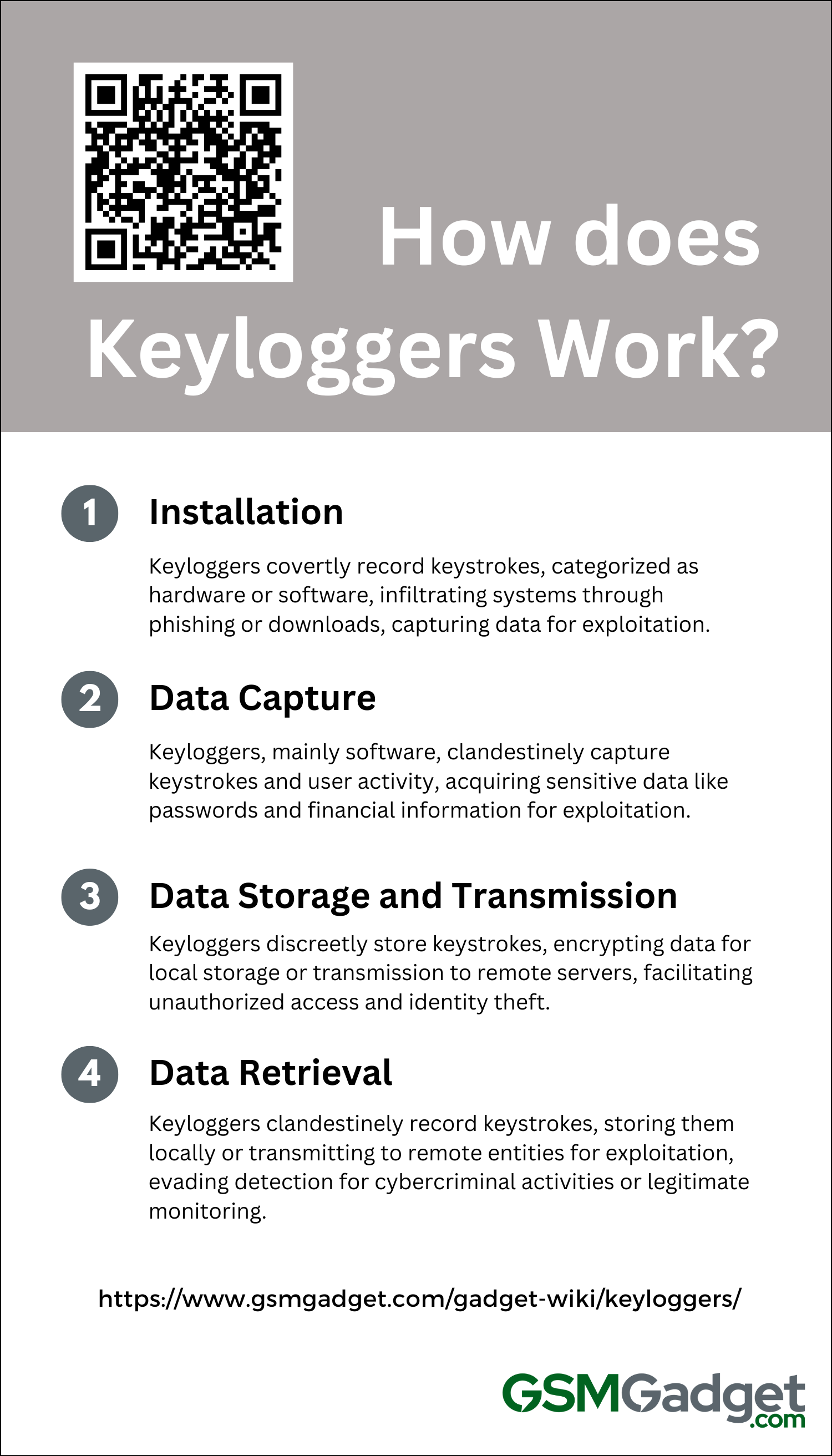
1. Installation
Keyloggers are surveillance tools that can secretly record keystrokes on a computer or device. These tools are typically categorized into two main forms: hardware and software. Hardware keyloggers are discreet physical devices that capture keystrokes by being connected between a keyboard and a computer, storing the data internally. On the other hand, software keyloggers are malicious programs that infiltrate a victim’s system through deceptive methods such as phishing, malicious downloads, or exploiting vulnerabilities. Once activated, they operate covertly in the background, capturing keystrokes, passwords, personal messages, taking screenshots, recording clipboard data, and monitoring user interactions. The collected information is either stored locally for later retrieval or sent directly to the cybercriminal through networking protocols. Some advanced software keyloggers even allow remote access to the infected device, significantly increasing the risks of cyber espionage and personal data theft.
2. Data Capture
Keyloggers are surveillance tools that capture and log every keystroke on a targeted device to collect user data input, including sensitive information like passwords and credit card numbers. Predominantly software-based for their stealth and ease of distribution, keyloggers are typically installed through malicious means such as downloads, email attachments, or compromised websites and operate undetected in the background. They may also record additional activities, such as taking screenshots and monitoring clipboard contents, to provide a detailed record of user behavior. Hardware keyloggers, requiring physical access, are connected to the keyboard or embedded within it, storing keystrokes in internal memory. Both variants store the captured data for later use or transmit it to an attacker, often posing serious privacy and security threats by enabling unauthorized access to confidential information.
3. Data Storage and Transmission
Keyloggers, whether hardware-based or software-driven, covertly capture every keystroke on a targeted device and systematically store this data, which may include sensitive information such as passwords and credit card numbers. Hardware keyloggers save the keystrokes to an internal or removable storage, while software keyloggers record them in encrypted log files on the device’s hard drive, sometimes compressing them for efficiency. Advanced keyloggers can transmit the encrypted data through various channels—email, FTP, or to a command-and-control server—either continuously or at scheduled intervals, enabling remote retrieval by the attacker without direct access to the compromised device, thereby facilitating activities such as identity theft or unauthorized account access.
4. Data Retrieval
Keyloggers are surveillance tools that covertly record every keystroke on a computer in order to capture sensitive data such as passwords and credit card numbers. Software keyloggers store this information in log files on the user’s device and may transmit it to a remote entity using methods such as email, FTP, or web interfaces. Hardware keyloggers store the data internally and can transmit it wirelessly if capable, or otherwise require physical retrieval. These tools can operate without detection by standard antivirus software, and may also capture screenshots or clipboard data. Their stealthy operation makes them valuable for cybercriminals seeking to exploit the information, or for legitimate monitoring in certain legal contexts.
Who uses keyloggers?
Cybersecurity professionals monitor for potential threats, while malicious actors seek to capture sensitive information using keyloggers. The following is a list of primary users who utilize keylogging tools in their operations:
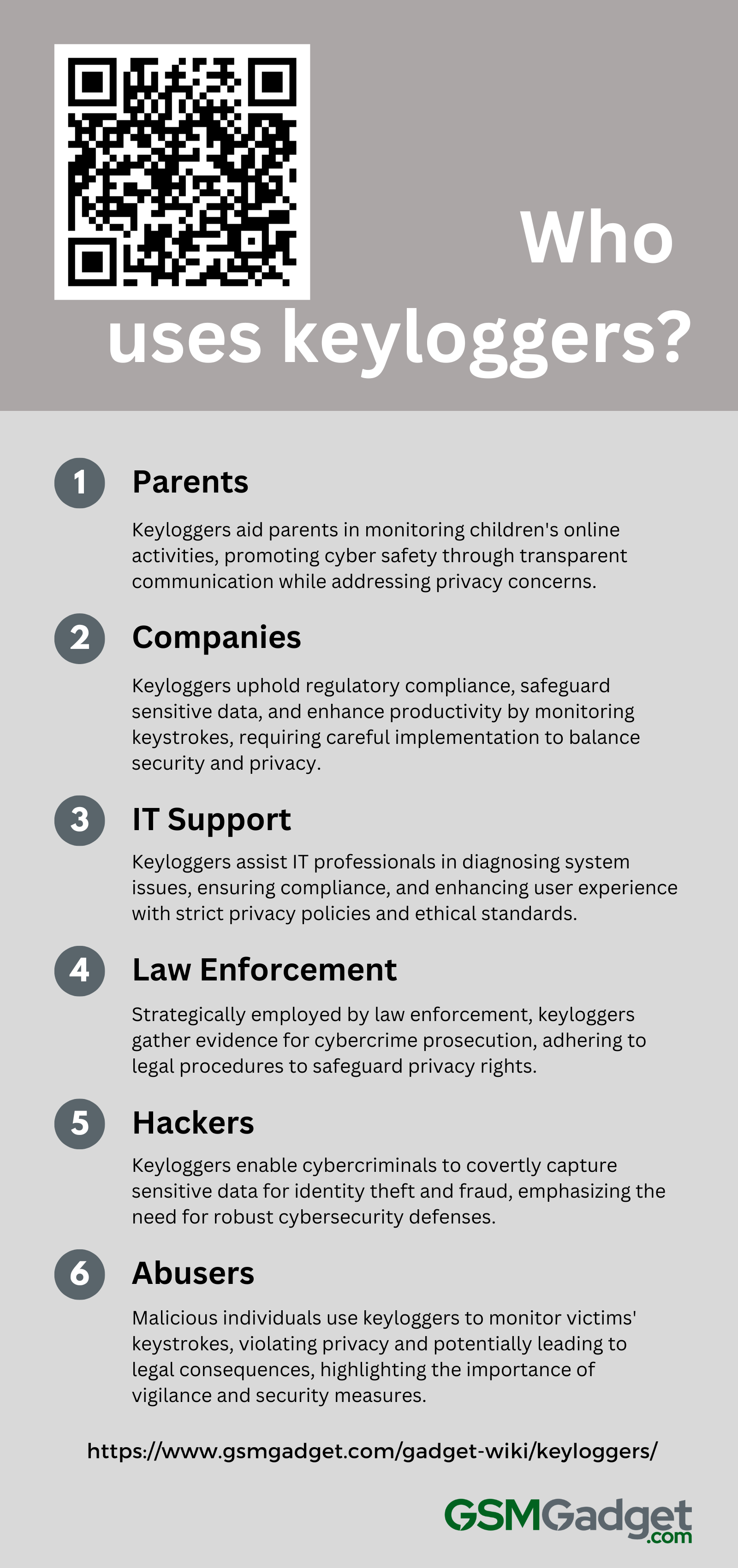
1. Parents
In the digital parenting landscape, keyloggers are a crucial tool for parents to monitor their children’s online activities and enhance cyber safety. These applications meticulously record every keystroke on a device, allowing guardians to track typed content such as messages, search queries, and website visits. Primarily used to protect children from digital dangers like cyberbullying, exposure to inappropriate content, and unwanted contact with strangers, keyloggers also require a cautious approach to privacy and trust issues. Tech-savvy parents aim to find a balance by being transparent about their monitoring efforts, fostering open communication and mutual understanding, all while prioritizing their children’s safety in the increasingly complex cyber world.
2. Companies
Keyloggers are utilized by companies in different industries, such as finance and healthcare, to monitor keystrokes on devices owned by the company and maintain strict regulatory compliance. These tools are essential for safeguarding sensitive data, preventing internal threats, and ensuring employee productivity by monitoring data entry levels and identifying abnormal keystroke patterns. In fields with high security requirements, like defense, keyloggers play a critical role in detecting potential breaches. However, the implementation of keyloggers must be carefully controlled to address privacy and ethical concerns, necessitating clear communication with employees regarding monitoring practices to find a balance between security and privacy rights.
3. IT support
In IT support, keyloggers are essential tools for diagnosing and monitoring system performance. They are utilized to record and analyze keystrokes in order to troubleshoot input device malfunctions or software issues, which are often indicated by irregular typing patterns. These tools assist IT professionals in identifying the underlying causes of problems, ensuring compliance with corporate policies, and safeguarding against unauthorized data entry. Despite the fact that keyloggers gather sensitive information, their implementation is carefully regulated with stringent privacy policies, ethical standards, and user consent to uphold transparency. Consequently, keyloggers play a crucial role in enhancing user experience and upholding strong system security within the IT support field.
4. Law enforcement
Law enforcement agencies strategically use keyloggers to gather evidence against individuals involved in cybercrime and other illegal activities. These keyloggers are discreetly installed on a suspect’s device with legal authorization, usually through a warrant. They record keystrokes and track user input to capture passwords, communications, and important data necessary for building a case. The use of keyloggers is closely monitored to safeguard privacy rights and is carefully overseen to prevent abuse and maintain the credibility of the evidence. Keyloggers are an essential tool in the digital forensic arsenal used to effectively prosecute cybercriminals.
5. Hackers
Keyloggers are a type of surveillance software that hackers use to secretly record keystrokes and collect sensitive data from individuals, businesses, and government entities. These tools are skilled at capturing passwords, financial information, private conversations, and intellectual property. Cybercriminals typically install keyloggers through phishing scams, infected website scripts, or by exploiting system vulnerabilities, allowing them to secretly monitor and log every keystroke on a compromised device. Operating discreetly in the background, keyloggers can remain undetected for extended periods, sending the gathered information back to the hackers. The data they collect can enable identity theft, financial fraud, and unauthorized access to systems, highlighting the crucial importance of robust cybersecurity defenses to detect and protect against these covert threats.
6. Abusers
Keyloggers, a type of surveillance technology that operates discreetly, are commonly utilized by individuals who engage in abusive behavior, such as domestic partners, cyberstalkers, and workplace harassers, to secretly monitor the keystrokes of their victims and gain unauthorized access to sensitive information such as passwords, private messages, and browsing history. These malicious individuals install keylogging software on a victim’s device without their permission, allowing them to capture all inputs and control the victim’s online activities, often as part of a larger pattern of stalking or intimate partner violence. The use of keyloggers by abusers can result in serious consequences, including a violation of privacy, psychological harm, and potential legal consequences for the perpetrators. It is illegal to install a keylogger without consent, which represents a clear breach of trust and privacy. To safeguard against such intrusive actions, individuals must remain vigilant, employ robust security measures, and regularly check their devices for any indications of this covert software.
Devices or systems affected by keyloggers (DND)
Keyloggers are a common security threat that can infiltrate a variety of devices and systems, secretly recording every keystroke made by the user. These malicious tools are not restricted to personal computers but have expanded to target a wider range of technology, presenting a substantial risk to data privacy and security.
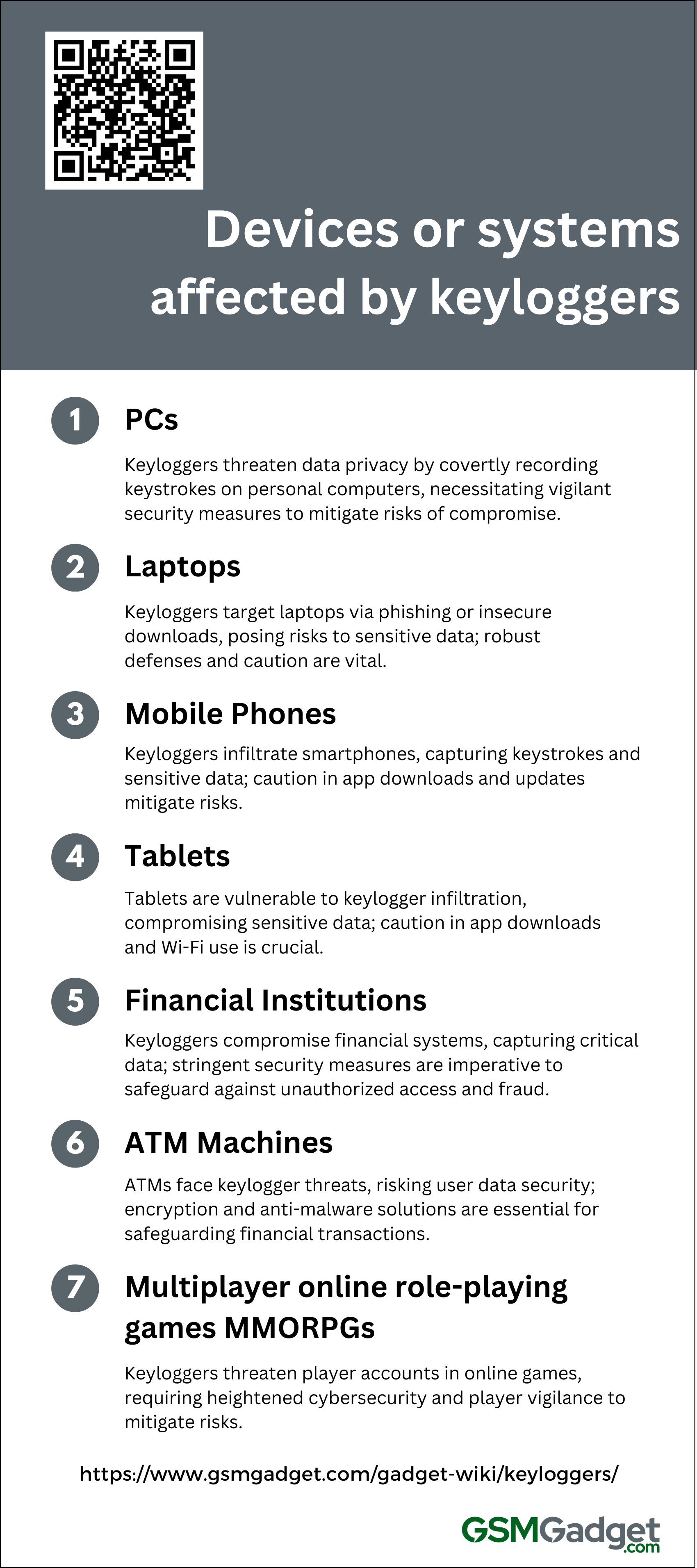
1. PCs
Personal computers (PCs) are highly vulnerable to keylogger attacks, which pose a threat to data privacy and security by secretly recording every keystroke made by a user. Keyloggers, whether in the form of software or hardware, can target systems running Windows, macOS, or Linux, and are commonly introduced through phishing emails, malicious downloads, or unauthorized physical access. Once activated, they have the ability to capture a wide range of sensitive information, including passwords, financial data, and private communications. The risk is particularly high during activities such as online banking or entering personal information on the internet. To protect against these vulnerabilities, PC users should remain vigilant by implementing robust security measures such as regular antivirus scans and exercising caution in their online interactions to reduce the likelihood of keylogger infiltration and the subsequent risks of data compromise and identity theft.
2. Laptops
Laptops are commonly targeted by keyloggers due to their widespread use in both personal and professional environments. These surveillance tools can be covertly installed through phishing, insecure downloads, or physical access, posing a significant risk by recording keystrokes to capture sensitive information such as passwords and financial data. The portability of laptops increases this vulnerability, as they are more easily lost or stolen, and using them on public Wi-Fi networks exposes them to additional threats. Instances involving HP laptops, which have been discovered with pre-installed keyloggers, underscore the importance of vigilance and the adoption of strict security measures. Users should prioritize strong defenses like updated antivirus software, firewalls, and regular system checks to protect against keyloggers and safeguard their personal information.
3. Mobile phones
Mobile phones, particularly smartphones, are increasingly targeted by keyloggers, which are malicious programs designed to secretly monitor and record every keystroke made on a device. These keyloggers can infiltrate mobile devices through various means, such as installing malicious apps, phishing schemes, or exploiting system vulnerabilities. Once installed, they can not only log keystrokes but also capture screenshots, track touch inputs, and even access cameras and microphones, putting personal and financial information at risk. While both Android and iOS devices are susceptible to such attacks, iOS’s closed ecosystem provides some protection through strict app review processes. Nevertheless, it is essential for users to exercise caution by regularly updating their operating systems and downloading apps only from trusted sources to minimize the risk of keylogger infiltration and protect their sensitive data.
4. Tablets
Tablets, which combine the portability of smartphones with the functionality of computers, are vulnerable to keylogger infiltration. Keyloggers are covert surveillance software that record every keystroke. These devices are especially at risk when users download malicious apps or click on compromised links, allowing keyloggers to capture all inputs, including passwords, personal conversations, and financial information. The use of virtual keyboards on tablets does not protect against such attacks. The various operating systems used on tablets and their frequent use on unsecured public Wi-Fi networks increase the susceptibility to these threats, making them an appealing target for cybercriminals seeking to obtain confidential information for malicious purposes.
5. Financial institutions
Keyloggers pose a significant cybersecurity threat to financial institutions by compromising critical devices and systems such as network servers, employee workstations, ATMs, and point-of-sale systems. These stealthy tools are designed to bypass traditional antivirus defenses and can capture sensitive data such as login credentials, account numbers, and PINs through covert keystroke recording. The increasing use of digital banking platforms has expanded the potential for keylogger attacks, emphasizing the immediate need for financial institutions to implement strict security measures. These measures should include encryption, multi-factor authentication, continuous monitoring, regular system updates, and comprehensive employee training to effectively mitigate the risk of unauthorized access and financial fraud.
6. ATM machines
Automated Teller Machines (ATMs) play a crucial role in the financial transaction network, but they are susceptible to keylogger attacks that pose a threat to user data security. Keyloggers, which can be discreet hardware devices attached to card readers or covert software within the machine’s system, are designed to capture users’ keystrokes in order to obtain sensitive information such as PINs and account details. These security breaches can result in unauthorized withdrawals and banking fraud, underscoring the importance of implementing strict security measures. Safeguarding ATMs against such threats is essential, and this includes utilizing encrypted PIN pads, conducting regular inspections, and employing advanced anti-malware solutions to ensure the security of financial transactions and uphold consumer confidence.
7. Multiplayer online role-playing games (MMORPGs)
In the world of Multiplayer Online Role-Playing Games (MMORPGs), keyloggers represent a formidable threat, compromising the security of player accounts and undermining the gaming experience. These insidious programs can be introduced to players’ systems through various means such as deceptive downloads, phishing schemes, or insecure networks, and proceed to covertly log every keystroke, capturing sensitive data like login credentials. This can result in unauthorized account access, loss of in-game assets, and even real-world financial implications. Keyloggers can target a wide array of internet-connected devices, including personal computers and gaming consoles, placing numerous MMORPG players in jeopardy. The ramifications of keylogger attacks are far-reaching, potentially facilitating the spread of in-game spam, distorting virtual economies, and disrupting gameplay, which in turn can tarnish the reputation of the gaming platform. The persistent risk of keyloggers underscores the critical need for heightened cybersecurity practices and player vigilance to thwart such intrusions.
Uses of Keyloggers
Keyloggers, often regarded with suspicion, serve a variety of purposes beyond malicious intent. They can enhance security protocols, optimize user interfaces, and provide valuable insights into user behavior and system vulnerabilities. Here are some key uses of keyloggers in both personal and professional settings:
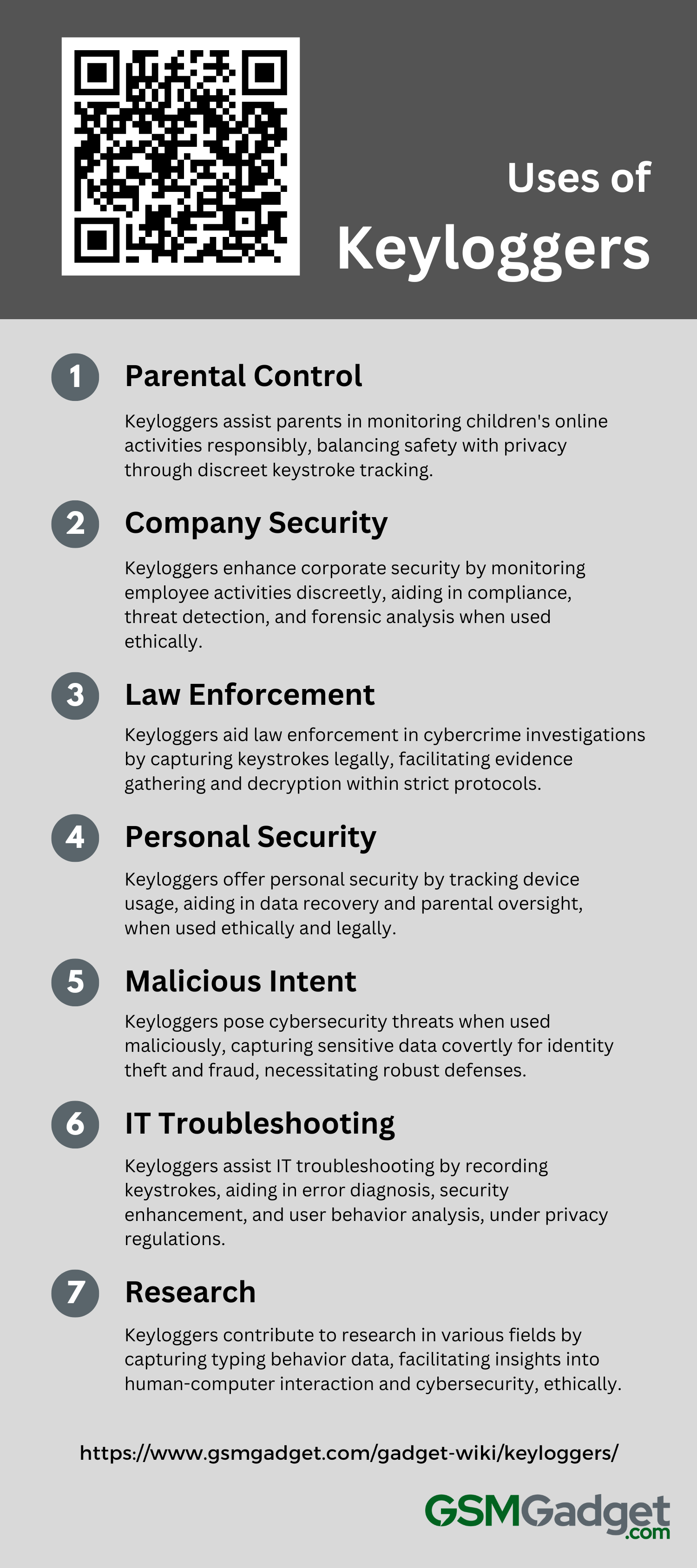
1. Parental Control
Keyloggers have become a valuable tool for parental control, allowing parents to discreetly monitor their children’s online activities and protect them from cyber threats such as cyberbullying, exposure to inappropriate content, and interactions with strangers. These tools record keystrokes on a device, providing information about a child’s internet usage, including their social media interactions, search history, and email communications. Responsible use of keyloggers helps parents identify opportunities to promote safe internet practices and intervene when necessary. However, it is important for parents to strike a balance between monitoring and respecting their child’s privacy, using keyloggers ethically with clear communication and adherence to legal standards for digital supervision.
2. Company Security
Keyloggers play a crucial role in company security by providing a discreet and effective method of monitoring employee activity to reduce internal threats and ensure compliance with corporate policies. These tools record keystrokes on devices, allowing for the observation of user behavior, identification of unauthorized access, and assistance in determining the source of data breaches. When used ethically and legally, keyloggers not only prevent the misuse of company resources but also aid in forensic analysis and bolster cybersecurity by detecting potential phishing or malware activities. They are particularly valuable in regulated industries for ensuring adherence to legal requirements. However, organizations must strike a balance between security and privacy rights, maintaining trust and integrity in the workplace by operating within legal boundaries and practicing transparency.
3. Law Enforcement
In law enforcement, keyloggers are essential tools for cybercrime investigation units, enabling the capture of every keystroke made on a suspect’s computer. This capability allows authorities to gather evidence on criminal activities such as fraud, identity theft, or unauthorized access to sensitive data. Utilized under strict legal protocols, these digital tools help police and federal agencies to decrypt encrypted communications, reveal passwords, and trace interactions with accomplices, effectively bypassing encryption used by criminals. The deployment of keyloggers requires legal authorization, such as warrants, to ensure privacy rights are respected. When used responsibly, keyloggers are a potent asset in the digital arsenal of law enforcement, striking a balance between crime-solving and upholding civil liberties.
4. Personal Security
Keyloggers, commonly associated with unauthorized surveillance, can also bolster personal security when used responsibly. They enable individuals to monitor their own device usage, providing a means to track and recover information in the event of theft or unauthorized access. Parents find keyloggers particularly useful for overseeing their children’s online interactions, thereby protecting them from cyber threats like predatory behavior and cyberbullying. Additionally, keyloggers offer a safeguard for typed data, acting as a safety net against data loss from system failures or accidental deletions. However, it is essential to use keyloggers in compliance with legal standards and with a respect for privacy to ensure they serve as a legitimate defense against security risks.
5. Malicious Intent
Keyloggers, when used with malicious intent, pose a significant threat to both personal and organizational cybersecurity by allowing cybercriminals to secretly capture every keystroke on a victim’s device. This covert surveillance technique is highly effective at obtaining passwords, credit card information, and other sensitive data, which can then be used for identity theft, financial fraud, corporate espionage, and other malicious activities. Keyloggers are often difficult to detect and can be disguised within seemingly harmless software or distributed through phishing attacks. The information collected by keyloggers is typically transmitted to remote servers for criminal purposes. The widespread presence of keyloggers and the challenges in identifying and removing them underscore the critical importance of robust cybersecurity measures to protect against privacy violations and security breaches.
6. IT Troubleshooting
In IT troubleshooting, keyloggers are valuable diagnostic tools that help IT professionals identify and resolve user-related issues by discreetly recording keystrokes. This allows for the reconstruction of user actions to pinpoint system errors or application malfunctions, especially when traditional error logs are insufficient or users cannot recall their actions. Additionally, keyloggers are important for detecting unauthorized access by capturing credentials, enhancing security. Their use in monitoring user interactions aids in diagnosing software and network issues, replaying problematic sequences, and understanding behaviors that may lead to system problems, which is crucial in complex environments where errors are hard to replicate. It is essential, however, that keylogger deployment complies with privacy laws and organizational policies to ensure transparency and that their use is limited to troubleshooting and security enhancement purposes.
7. Research
Keyloggers, commonly linked to cyber espionage, serve important roles in research across various fields, including human-computer interaction, behavioral analysis, cybersecurity, linguistics, and writing processes. Researchers leverage these tools to collect data on user typing behavior, such as patterns, error rates, and response times, which is essential for crafting more intuitive user interfaces and enhancing digital accessibility. In cybersecurity, keyloggers help simulate attacks to evaluate security protocols and devise countermeasures. Academic studies also benefit from keyloggers by analyzing how individuals construct text and navigate software applications, contributing to advancements in technology that prioritize user experience. It is imperative, however, that research involving keyloggers is conducted with strict adherence to ethical standards, ensuring informed consent from participants to safeguard privacy and uphold the integrity of the research.
Detecting keyloggers
Keyloggers are stealthy surveillance tools that can pose significant threats to personal and organizational cybersecurity. These tools, whether software or hardware, record every keystroke, capturing sensitive information such as passwords and financial data. Understanding how to detect keyloggers is crucial for maintaining digital privacy and security.
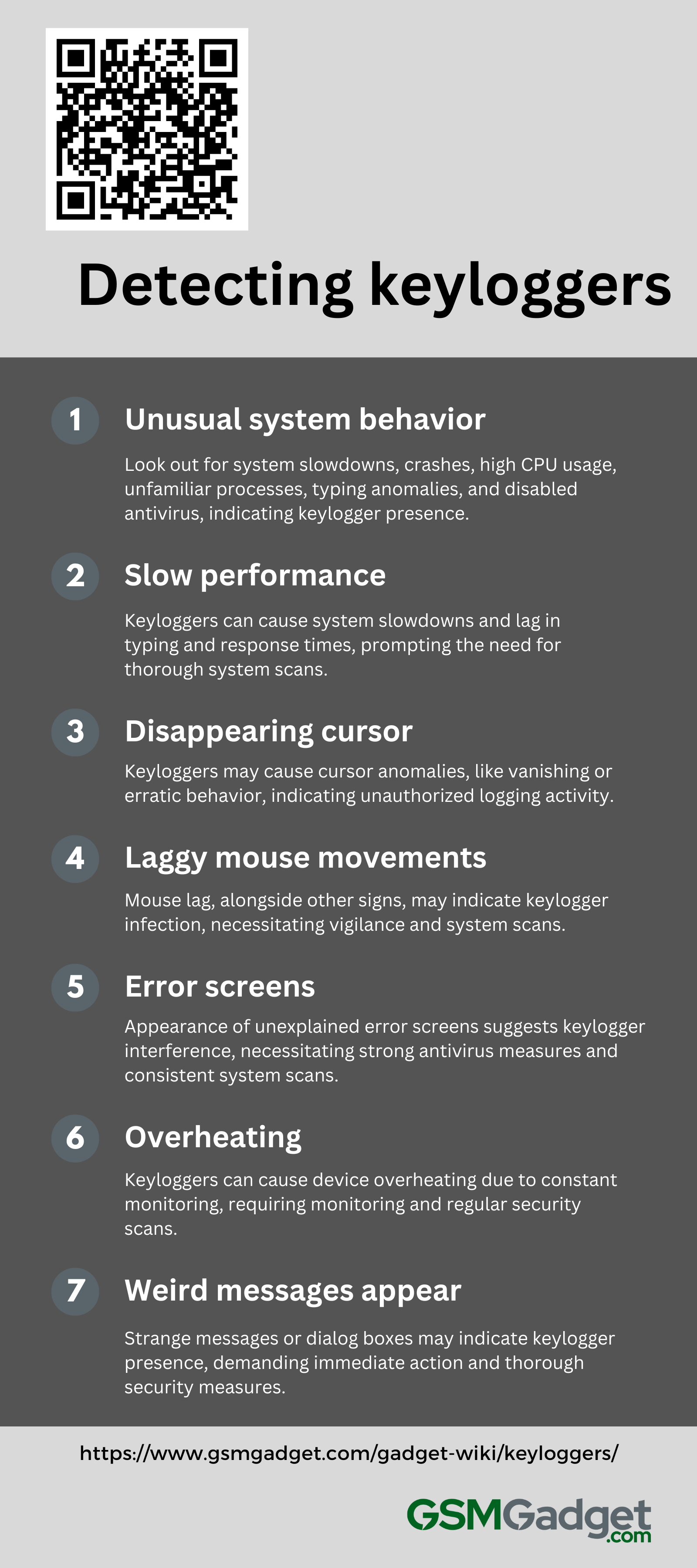
1. Unusual system behavior
Keyloggers, surveillance tools that record keystrokes, can be detected through careful monitoring of system irregularities. Telltale signs of a keylogger compromise include significant system slowdowns, frequent crashes, high CPU usage without active tasks, and unfamiliar processes in the task manager. Users may also encounter typing anomalies such as delays or unintended characters appearing, and antivirus software may be inexplicably disabled or produce continuous errors. These symptoms suggest that the keylogger is taxing system resources or disrupting normal operations, and they serve as a critical warning that your system’s security may be at risk. To protect sensitive information, it is essential to remain observant of these indicators and promptly perform a security scan if such behaviors are observed.
2. Slow performance
A noticeable slowdown in system performance can be a key indicator of a keylogger’s presence on your device, as these stealthy, malicious programs are designed to covertly record your keystrokes and can significantly tax system resources. This can lead to sluggish response times, delayed typing feedback, and general lag when performing tasks that are typing-intensive or involve navigating the operating system. Such performance issues, particularly if they arise suddenly, should prompt you to conduct a comprehensive system scan with updated antivirus and anti-malware tools to detect and eliminate any keyloggers or related malware compromising your system’s efficiency.
3. Disappearing cursor
A disappearing cursor can be a subtle yet alarming sign of keylogger activity on your system. These malicious programs are engineered to covertly record your keystrokes and may cause cursor anomalies, such as vanishing or erratic behavior, particularly noticeable while typing or navigating. Such disruptions could indicate that a keylogger is actively capturing your input. To protect your personal data from these unauthorized logging activities, it is essential to keep your antivirus software up to date, utilize strong firewalls, and remain alert to any odd system behaviors. Regularly scanning your system with reliable security tools is also key to detecting and eliminating these hidden threats, thereby ensuring the security of your personal information.
4. Laggy mouse movements
Laggy mouse movements can be a subtle indicator of a keylogger infection, a type of malicious software that records keystrokes and possibly other actions. Such lag may occur when a keylogger consumes significant system resources, either due to poor coding or because it is capturing large amounts of data. This can cause a noticeable delay in cursor movement, particularly if no other resource-heavy applications are active. While there can be other reasons for mouse lag, such as hardware issues, it’s important to consider the possibility of a keylogger if the lag is accompanied by other suspicious signs like slow browsing or unexplained errors. To protect personal privacy and data security, users should remain vigilant, conduct system scans with trusted security tools, and monitor task manager for unauthorized processes that could indicate the presence of keylogging software.
5. Error screens
In the critical field of cybersecurity, maintaining vigilance against keyloggers is essential, as they are designed to covertly capture every keystroke and jeopardize sensitive information. A common indicator of a keylogger’s presence is the appearance of unexplained error screens, which may include system crashes, application freezes, or unexpected dialog boxes, especially when they occur during routine tasks or with software that typically operates smoothly. These disruptions could suggest that a keylogger is tampering with system processes. While innovative detection methods, such as analyzing timing discrepancies in keystroke registration, exist, they require advanced equipment and are not definitive. Users are advised to implement strong antivirus programs, regularly update their systems, and stay alert to unusual system behaviors like frequent error screens. These measures, along with consistent system scans using trusted anti-malware software, are crucial for identifying and mitigating the hidden risks posed by keylogging software.
6. Overheating
Keyloggers are clandestine programs that can cause your device to overheat due to their constant keystroke monitoring, which increases CPU usage. This overheating can be a red flag, particularly if it occurs during light tasks or persists after closing background applications. If you notice your system running hotter than usual without a clear cause, it could be a sign of a keylogger operating covertly. To counteract these threats, keep an eye on your device’s performance and temperature, and conduct regular security scans to detect and prevent any unauthorized keylogging activity.
7. Weird messages appear
The unexpected emergence of strange messages or dialog boxes on your system can signal the presence of a keylogger, with symptoms like garbled text, random characters, or inexplicable error messages. These disruptions often stem from keyloggers that tamper with the normal input-output functions of your operating system, leading to conspicuous system behavior. Such irregularities should prompt users to take action, as they may indicate that keystroke integrity and confidentiality are at risk. To address this, it’s crucial to perform a comprehensive security scan with trusted anti-malware tools, update your system regularly, and remain alert to any odd application behavior, which are essential practices for identifying and eradicating keyloggers.
Tools and Techniques to Prevent Keylogging
Keyloggers pose a significant threat to personal and organizational cybersecurity by stealthily recording keystrokes to capture sensitive information. To combat this risk, it is essential to employ a variety of tools and strategies designed to detect and prevent these malicious programs. Here are some effective measures you can take to safeguard your devices from keylogging attacks:
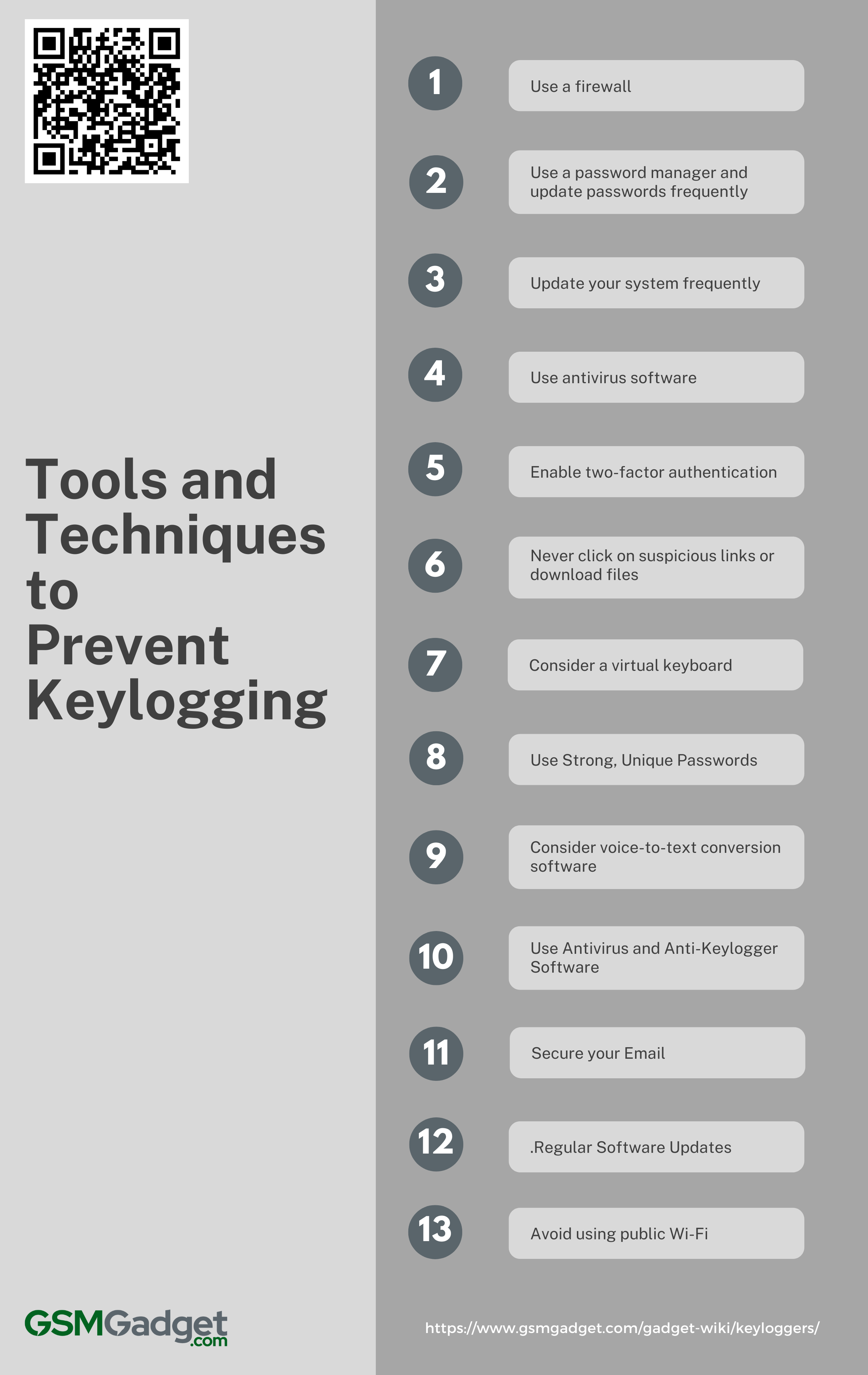
- Use a firewall
- Use a password manager and update passwords frequently
- Update your system frequently
- Use antivirus software
- Enable two-factor authentication
- Never click on suspicious links or download files
- Consider a virtual keyboard
- Use Strong, Unique Passwords
- Consider voice-to-text conversion software
- Use Antivirus and Anti-Keylogger Software
- Secure your Email
- Regular Software Updates
- Avoid using public Wi-Fi
